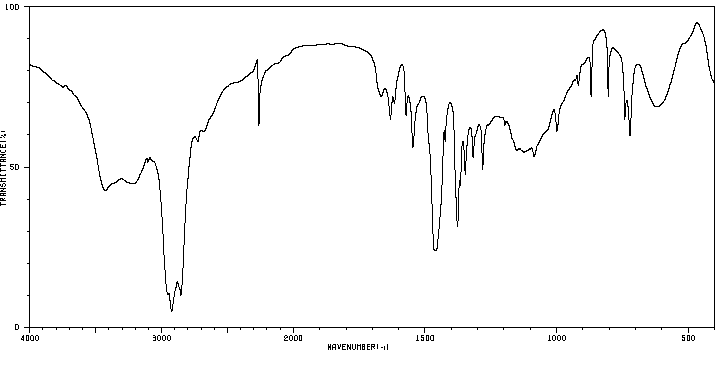1,5-naphthalenedisulfonate anion | 22713-47-9
中文名称
——
中文别名
——
英文名称
1,5-naphthalenedisulfonate anion
英文别名
1,5-naphthalene disulfonate;naphthalene-1,5-disulfonate;1,5-naphthalenedisulfonate;1,5-NDS;naphthalene-1,5-disulfonic acid dianion;Naphthalin-1.5-disulfonat
CAS
22713-47-9
化学式
C10H6O6S2
mdl
——
分子量
286.286
InChiKey
XTEGVFVZDVNBPF-UHFFFAOYSA-L
BEILSTEIN
——
EINECS
——
-
物化性质
-
计算性质
-
ADMET
-
安全信息
-
SDS
-
制备方法与用途
-
上下游信息
-
文献信息
-
表征谱图
-
同类化合物
-
相关功能分类
-
相关结构分类
计算性质
-
辛醇/水分配系数(LogP):0.4
-
重原子数:18
-
可旋转键数:0
-
环数:2.0
-
sp3杂化的碳原子比例:0.0
-
拓扑面积:131
-
氢给体数:0
-
氢受体数:6
反应信息
-
作为反应物:描述:1.6.20.25-四偶氮[6.1.6.1]环苯 、 1,5-naphthalenedisulfonate anion 生成 naphthalene-1,5-disulfonate;7,12,22,27-tetrazapentacyclo[26.2.2.23,6.213,16.218,21]octatriaconta-1(30),3(38),4,6(37),13(36),14,16(35),18,20,28,31,33-dodecaene参考文献:名称:KOGA, KENJI;ODASHIMA, KAZUNORI, J. INCL. PHENOM., 7,(1989) N, C. 53-60摘要:DOI:
-
作为试剂:描述:3,3-bis-fluoromethyl-1-bromo-1-(4-chlorophenoxy)-butan-2-one 、 咪唑 、 1,5-萘二磺酸(四水合物) 在 水 、 Sodium sulfate-III 、 1,5-naphthalenedisulfonate anion 、 compound 、 碳酸氢钠 作用下, 以 乙腈 为溶剂, 反应 4.0h, 以14 g (24% of theory) of 3,3-bis-fluoromethyl-1-(4-chlorophenoxy)-1-(imidazol-1-yl)-butan-2-one were obtained as a viscous oil的产率得到3,3-bis-fluoromethyl-1-(4-chlorophenoxy)-1-(imidazol-1-yl)-butan-2-one参考文献:名称:Combating fungi with 1-phenoxy -1-imidazol-1-yl-4-fluoro-butane摘要:具有杀菌性能的公式为##STR1##的1-Phenoxy-1-imidazol-1-yl-4-fluoro-butane衍生物,其中B为--CO-或--CH(OH)--,X为氢或氟,Z各自独立为卤素,烷基,硝基,氰基,烷氧基-羰基或可选取代的苯基,n为0,1,2或3,或其酸或金属盐加合物。公开号:US04419361A1
文献信息
-
Fluorescent ligand design for mononuclear copper(I) complex fluorescence in aqueous solution作者:Makoto Saga、Genta Sakane、Shigeo Yamazaki、Keiitsu SaitoDOI:10.1016/j.ica.2019.119368日期:2020.3these Cu(II) complexes were synthesized. The fluorescence of [Cu(I/II)(qdeta)]+/2+ and [Cu(I/II)(bpqa)]+/2+ in aqueous solution was characterized; [Cu(I)(qdeta)]+ and [Cu(I)(bpqa)]+ were found to fluoresce in aqueous solution, whereas the fluorescence of [Cu(II)(qdeta)]2+ and [Cu(II)(bpqa)]2+ was almost completely quenched. The chelation enhanced fluorescence effect was observed for both [Cu(I)(qdeta)]+摘要合成了荧光配体3-(2-甲基喹啉基)二亚乙基三胺(QDETA)和双(2-吡啶基甲基)(2-喹啉基甲基)胺(BPQA),并合成了这些Cu(II)配合物。表征了水溶液中[Cu(I / II)(qDETA)] + / 2+和[Cu(I / II)(bpqa)] + / 2+的荧光。发现[Cu(I)(qDETA)] +和[Cu(I)(bpqa)] +在水溶液中发荧光,而[Cu(II)(qDETA)] 2+和[Cu(II) (bpqa)] 2+几乎被完全淬灭。对于[Cu(I)(qDETA)] +和[Cu(I)(bpqa)] +均观察到螯合增强了荧光作用。通过单晶X射线晶体学表征五配位的Cu(II)络合物[Cu(II)(qDETA)(H 2 O)] NDSA·2H 2 O(NDSA = 1,5-萘二磺酸根阴离子)。
-
Synthesis, structure, characterization, and multifunctional properties of a family of rare earth organic frameworks作者:Haoran Li、Tianlu Sheng、Zhenzhen Xue、Xiaoquan Zhu、Shengmin Hu、Yuehong Wen、Ruibiao Fu、Chao Zhuo、Xintao WuDOI:10.1039/c7ce00202e日期:——A series of isomorphic 3D layered rare earth hydroxide (LREH) frameworks RE3(OH)7(1,5-NDS) (RE = Y (1), Gd (2), Er (3), Yb (4); 1,5-NDS = 1,5-naphthalenedisulfonate) has been synthesized under hydrothermal conditions. The crystal structures, thermal stabilities, photoluminescence, and magnetic properties of these compounds have been investigated. The results demonstrate that the compounds are highly
-
Two M(II)-1,5-NDS-dafo supramolecular architectures (M = Cu, Cd): syntheses, structures, and photoluminescence properties作者:Shuai Shao、Yu-Lan Zhu、Kui-Rong Ma、Hui-Chao Zhao、Yong-Qing QiuDOI:10.1080/00958972.2013.813938日期:2013.8.1Under hydrothermal conditions, reaction of Cu(II)/Cd(II) salts with 1,5-naphthalenedisulfonate (1,5-NDS) and 4,5-diazafluoren-9-one (dafo) afforded [Cu(dafo)(2)(1,5-NDS)](n) (1) and [Cd(dafo)(2)(1,5-NDS)](n) (2), respectively. The compounds were characterized by elemental analysis, IR, PXRD, TG-DSC, and single-crystal X-ray diffraction. Both 1 and 2, which are the first M(II)-1,5-NDS-dafo systems, exhibit 3-D supramolecular structures generated by 1-D chains via C-HO hydrogen bonds and - interactions. Solid-state photoluminescence properties of both 1 and 2 were investigated with emission bands at 426-496nm ((ex)=280, 270nm for 1 and 2, respectively).
-
Syntheses, structures, and photoluminescence properties of Zn(II)/Cd(II) supramolecular architectures based on 1,5-naphthalenedisulfonate and 1,10-phenanthroline ligands作者:Yulan Zhu、Shuai Shao、Kuirong Ma、Huichao Zhao、Yongqing QiuDOI:10.1007/s00706-013-1037-0日期:2013.10Two new supramolecular transition metal compounds, [Zn(phen)(2)(1,5-NDS)(H2O)] and [Cd(phen)(2)(1,5-NDS)](n) (1,5-NDS = 1,5-naphthalenedisulfonate, phen = 1,10-phenanthroline), were obtained under hydrothermal/solvothermal conditions and structurally characterized by elemental analysis, IR, PXRD, TG-DSC, and single-crystal X-ray determination. They represent the first examples of Zn(II)/Cd(II) supramolecular compounds based on the 1,5-NDS/phen system. The Zn compound exhibits a 3D supramolecular structure via hydrogen bond (O-Ha <-O and C-Ha <-O) and pi-pi interactions. The Cd compound is a 3D supramolecular framework generated by 1D coordinated chains through a hydrogen bond (C-Ha <-O) and pi-pi interactions. In addition, photoluminescence properties for both have been discussed. [Zn(phen)(2)(1,5-NDS)(H2O)] shows an emission peak at 420 nm (lambda (ex) = 342 nm), and [Cd(phen)(2)(1,5-NDS)] (n) displays a strong emission peak at 388 nm with a shoulder peak at 369 nm (lambda (ex) = 332 nm)..
-
Cage‐To‐Cage Transformations in Self‐Assembled Coordination Cages Using “Acid/Base” or “Guest Binding‐Induced Strain” as Stimuli作者:Vellaiyadevan Sivalingam、Minaz Parbin、Shobhana Krishnaswamy、Dillip Kumar ChandDOI:10.1002/anie.202403711日期:2024.6.3Controlling supramolecular systems between different functional forms by utilizing acids/bases as stimuli is a formidable challenge, especially where labile coordination bonds are involved. A pair of acid/base responsive, interconvertible 1,5‐enedione/pyrylium based Pd2L4‐type cages are prepared that exhibit differential guest binding abilities towards disulfonates of varied sizes. A three‐state switch has been achieved, where (i) a weakly coordinating base induced cage‐to‐cage transformation in the first step, (ii) a strongly coordinating base triggered cage disassembly as the second step, and (iii) the third step shows acid(strong) promoted generation of initial cage, thereby completing the cycle. To our surprise, binding of a specific disulfonate guest facilitated cage‐to‐cage transformations by inducing strain on the cage assembly thereby opening the labile pyrylium rings of the cage. Through competitive guest binding study, we demonstrated superior guest binding capability of octa‐cationic pyrylium‐based cage over a similar‐sized tetra‐cationic cage. These results provide a reliable approach to reversibly modulate the guest binding properties of acid/base‐responsive self‐assembled coordination cages.
表征谱图
-
氢谱1HNMR
-
质谱MS
-
碳谱13CNMR
-
红外IR
-
拉曼Raman
-
峰位数据
-
峰位匹配
-
表征信息
同类化合物
(S)-溴烯醇内酯
(R)-3,3''-双([[1,1''-联苯]-4-基)-[1,1''-联萘]-2,2''-二醇
(3S,3aR)-2-(3-氯-4-氰基苯基)-3-环戊基-3,3a,4,5-四氢-2H-苯并[g]吲唑-7-羧酸
(3R,3’’R,4S,4’’S,11bS,11’’bS)-(+)-4,4’’-二叔丁基-4,4’’,5,5’’-四氢-3,3’’-联-3H-二萘酚[2,1-c:1’’,2’’-e]膦(S)-BINAPINE
(11bS)-2,6-双(3,5-二甲基苯基)-4-羟基-4-氧化物-萘并[2,1-d:1'',2''-f][1,3,2]二氧磷
(11bS)-2,6-双(3,5-二氯苯基)-4羟基-4-氧-二萘并[2,1-d:1'',2''-f][1,3,2]二氧磷杂七环
(11bR)-2,6-双[3,5-双(1,1-二甲基乙基)苯基]-4-羟基-4-氧化物-二萘并[2,1-d:1'',2''-f][1,3,2]二氧杂磷平
黄胺酸
马兜铃对酮
马休黄钠盐一水合物
马休黄
食品黄6号
食品红40铝盐色淀
飞龙掌血香豆醌
颜料黄101
颜料红70
颜料红63
颜料红53:3
颜料红5
颜料红48单钠盐
颜料红48:2
颜料红4
颜料红261
颜料红258
颜料红220
颜料红22
颜料红214
颜料红2
颜料红19
颜料红185
颜料红184
颜料红170
颜料红148
颜料红147
颜料红146
颜料红119
颜料红114
颜料红 9
颜料红 21
颜料橙7
颜料橙46
颜料橙38
颜料橙3
颜料橙22
颜料橙2
颜料橙17
颜料橙 5
颜料棕1
顺式-阿托伐醌-d5
雄甾烷-3,17-二酮







